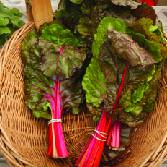-
CATEGORY ::
- All Seeds /
- All Flower Seeds /
- All Poppy Seeds











Poppy Seeds - Alpine
SEASON
Perennial
USDA ZONES
5 - 10
HEIGHT
8 - 10 inches
BLOOM SEASON
Late spring to late summer
BLOOM COLOR
Mix
ENVIRONMENT
Full sun
SOIL TYPE
Loam to sandy loam, pH 5.1 - 6.5
DEER RESISTANT
Yes
SEASON
Perennial
USDA ZONES
4 - 9
HEIGHT
24 - 36 inches
BLOOM SEASON
Late spring through early summer
BLOOM COLOR
Black and white
ENVIRONMENT
Full sun
SOIL TYPE
Well drained soil, pH 5.5 - 7.5
DEER RESISTANT
Yes
SEASON
Perennial
USDA ZONES
3 - 8
HEIGHT
12 inches
BLOOM SEASON
Mid spring to early summer
BLOOM COLOR
Orange
ENVIRONMENT
Full sun
SOIL TYPE
Loose, well-drained, pH 6.1 - 7.3
DEER RESISTANT
Yes
SEASON
Annual
USDA ZONES
3 - 10
HEIGHT
10 - 12 inches
BLOOM SEASON
Mid spring to late summer
BLOOM COLOR
Mix
ENVIRONMENT
Full sun
SOIL TYPE
Prefers gritty, fast-draining conditions, pH 6.6 - 7.5
DEER RESISTANT
Yes
SEASON
Annual
USDA ZONES
3 - 10
HEIGHT
12 inches
BLOOM SEASON
Mid spring to late summer
BLOOM COLOR
Pink
ENVIRONMENT
Full sun
SOIL TYPE
Prefers gritty, fast-draining conditions, pH 6.6 - 7.5
DEER RESISTANT
Yes
SEASON
Annual
USDA ZONES
3 - 10
HEIGHT
10 inches
BLOOM SEASON
Mid spring to late summer
BLOOM COLOR
Yellow
ENVIRONMENT
Full sun
SOIL TYPE
Prefers gritty, fast-draining conditions, pH 6.6 - 7.5
DEER RESISTANT
Yes
SEASON
Annual
USDA ZONES
3 - 10
HEIGHT
10 inches
BLOOM SEASON
Mid spring to late summer
BLOOM COLOR
White
ENVIRONMENT
Full sun
SOIL TYPE
Prefers gritty, fast-draining conditions, pH 6.6 - 7.5
DEER RESISTANT
Yes
SEASON
Annual
USDA ZONES
3 - 10
HEIGHT
10 inches
BLOOM SEASON
Mid spring to late summer
BLOOM COLOR
Red
ENVIRONMENT
Full sun
SOIL TYPE
Prefers gritty, fast-draining conditions, pH 6.6 - 7.5
DEER RESISTANT
Yes
About...
Alpine Poppy (Papaver Alpinum) - Start Alpine Poppy seeds for this short-growing perennial Poppy plant. This colorful mix of Poppy flowers range from orange, yellow, cream and scarlet. The blooms are 1 - 2 inches across. The Papaver Alpinum Poppy is well-suited to high elevations, and it originally came from the Alps.MORE POPPY OPTIONS
Planting Directions
TEMPERATURE
68F
AVERAGE GERM TIME
7 - 14 days
LIGHT REQUIRED
Yes
DEPTH
Do not cover seed
SOWING RATE
5 - 6 seeds per plant
MOISTURE
Keep seeds moist until germination
PLANT SPACING
6 - 9 inches





Alpine Poppy (Papaver Alpinum) - Start Alpine Poppy seeds for this short-growing perennial Poppy plant. This colorful mix of Poppy flowers range from orange, yellow, cream and scarlet. The blooms are 1 - 2 inches across. The Papaver Alpinum Poppy is well-suited to high elevations, and it originally came from the Alps. Alpine Poppy plants have strong taproots and make a good rockery plant. Alpine Poppies do best in average garden soils that drain well. How To Grow Poppies from Flower Seeds: Directly sow Alpine Poppy seeds into prepared seed beds. Clear the bed of weeds and loosen the top several inches of soil. Press the flower seeds into the soil and keep moist. Poppy seeds can be started in the early spring and do best in cool temperatures.
Common Questions
Are alpine poppy easy to grow?
Yes, these are easy to grow and virtually carefree.
What are common landscape styles to use alpine poppies?
These flowers make a lovely addition to rock gardens, gravel gardens, cottage gardens and the front of borders.
How long to these poppies take to bloom?
Alpine poppies if planted in the fall or early spring will bloom their first season.
Planting Directions
TEMPERATURE
60F
AVERAGE GERM TIME
14 - 28 days
LIGHT REQUIRED
Yes
DEPTH
Surface sow up to 1/8th inch deep
SOWING RATE
5 - 6 seeds per plant
MOISTURE
Keep seeds moist until germination
PLANT SPACING
14 inches





Poppy Checkers (Papaver Orientale Checkers) - This beautiful flowering poppy plant will grow 24 - 36 inches tall. It prefers full sun and blooms most frequently in late spring through early summer. Plant Papaver Checkers within the perennial border, add to container planting, and makes nice companion for spring blooming bulbs. This perennial poppy has a clumping habit which results in more blooms per plant. The poppy flowers are huge and can reach 6 inches in diameter. Plant these poppy seeds in well-drained soil with a pH between 5.5 - 7.5. These flower seeds are very easy to germinate.
Common Questions
Do I need to fertilize oriental poppy?
Use a slow-release fertilizer in the spring. Be sure to follow product label directions. Another option is to side dress the soil with compost or manure tea.
Can I grow oriental poppy in a container?
Yes, however it is not ideal. These plants have a long tap root that do much better in garden soil. If containers are still something you would like to try choosing a container deep enough to handle the long tap root (terra cotta pots are best). Use quality potting mix with slow-release fertilizer, water deeply and always keep soil moist.
Do I need to winterize my oriental poppy plants?
Oriental poppies are winter hardy to USDA zone 8, they do benefit from a layer of mulch before winter sets in to protect the roots. If you are growing your flowers in a container, you can bury the container in garden soil or wrap with burlap or bubble wrap for protection. They can also be moved indoors.
Should Oriental poppies be cut back?
There's no need to trim them back, as the foliage naturally dies off after blooming. However, if you prefer a tidier look, you can cut the wilted leaves down to the ground.
Will Oriental poppies bloom in the first year?
The timing of when you plant the seeds is crucial. They require a cold period to flourish, so if you sow them in the spring, they won’t bloom until the next year.
Planting Directions
TEMPERATURE
60 - 65F
AVERAGE GERM TIME
14 - 21 days
LIGHT REQUIRED
Yes
DEPTH
Surface sow seeds just barely covering
SOWING RATE
3 - 4 seeds per plant
MOISTURE
Keep seeds moist until germination
PLANT SPACING
8 - 10 inches
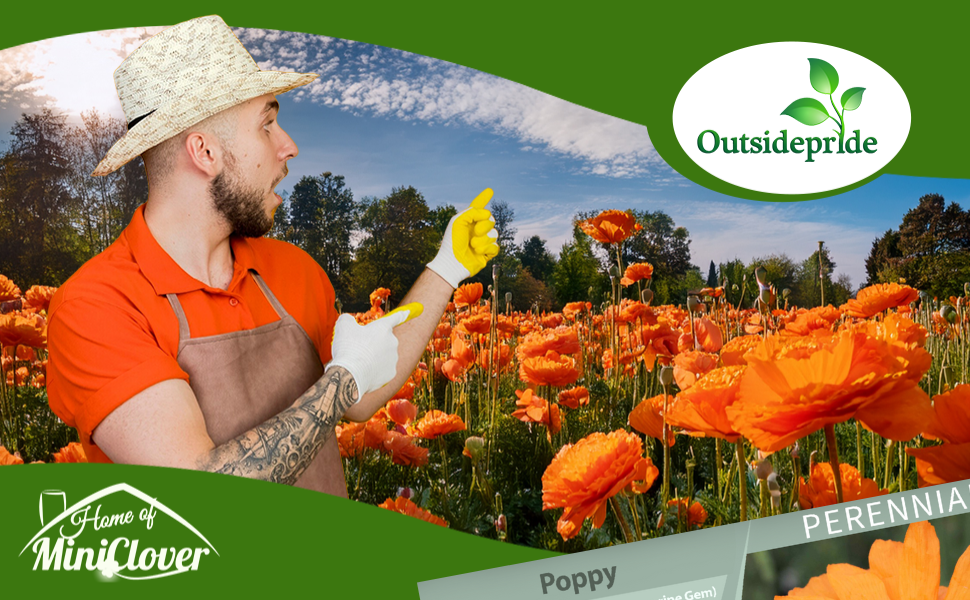

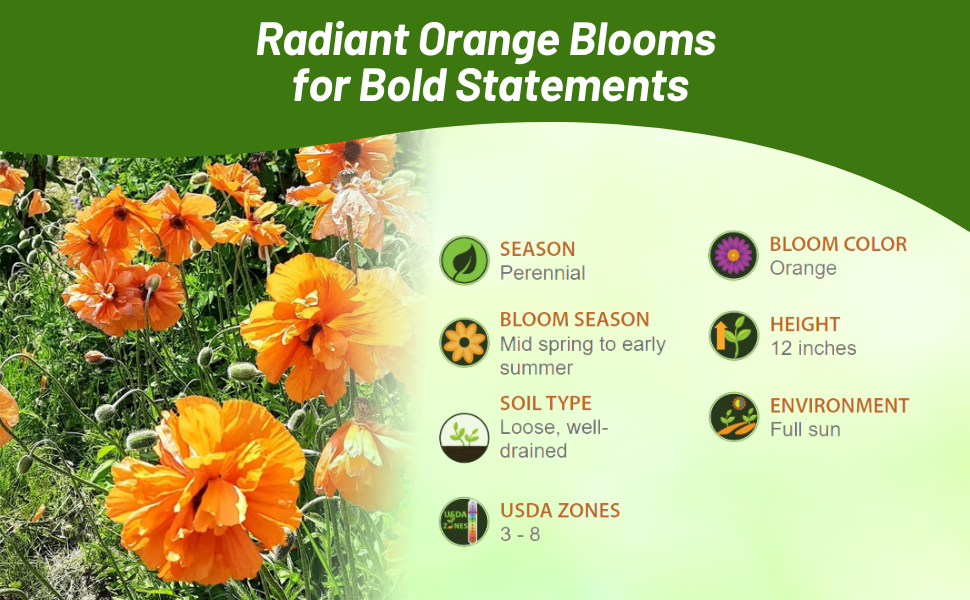
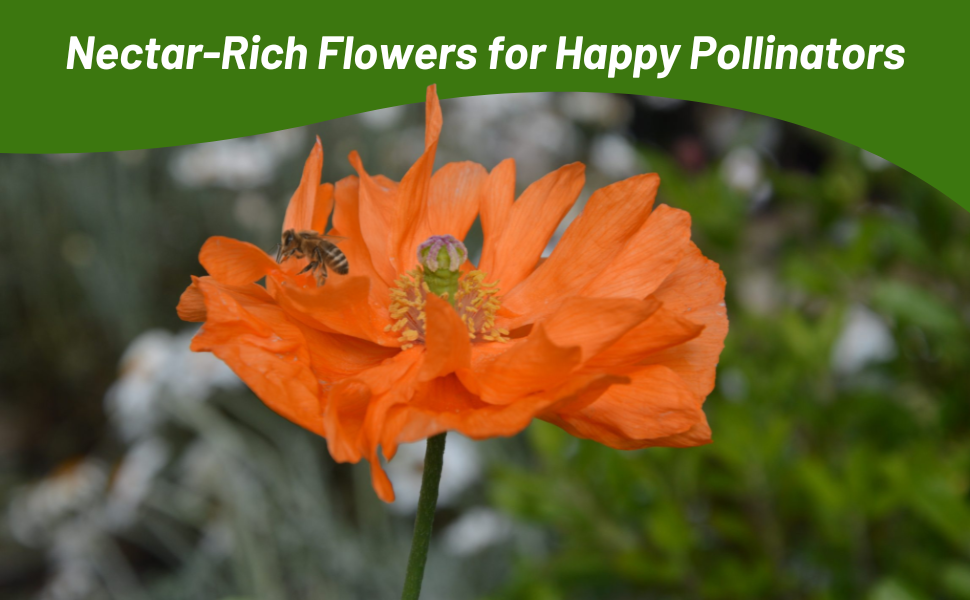
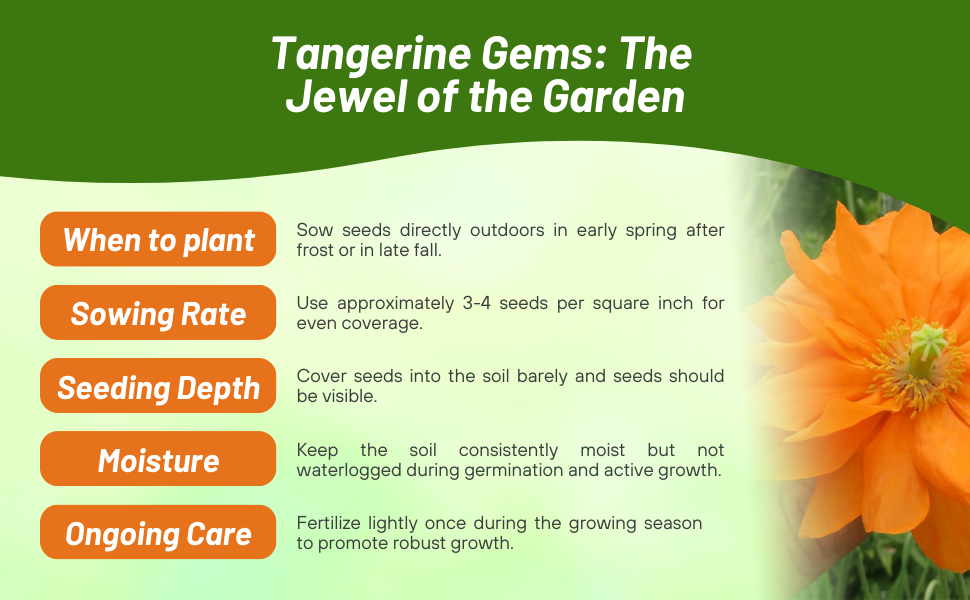
Poppy (Papaver rupifragum Double Tangerine Gem) - This perennial flower is a native of Morocco and brings saturated tangerine tones to the most rocky and arid landscapes. Fully double orange blooms of overlapping rings of paper-thin silky petals with Ferny, silver-blue foliage only growing 12 inches tall. Sunlight makes the translucent petals of Papaver Double Tangerine positively glow with color. The fascinating attractive seedpods will add a nice touch to dried arrangements. This cute little robust plant looks best in a rock garden or edging a hot, sunny border.
This pollinator-attracting blooms in the first year and reseeds readily. In 1890, Sir William Jackson Hooker described finding P. rupifragum growing in dry, rocky places of southern Morocco at an elevation of 6,000 - 7,000 feet. Indeed, this drought-tolerant plant is perfect for meadows, xeriscaping, rocky gardens, and sunny, dry locations!
















